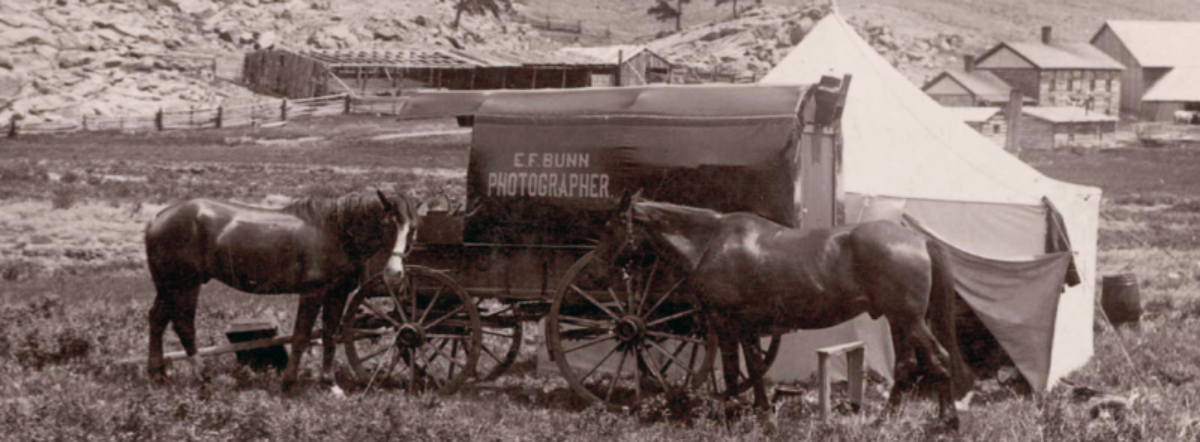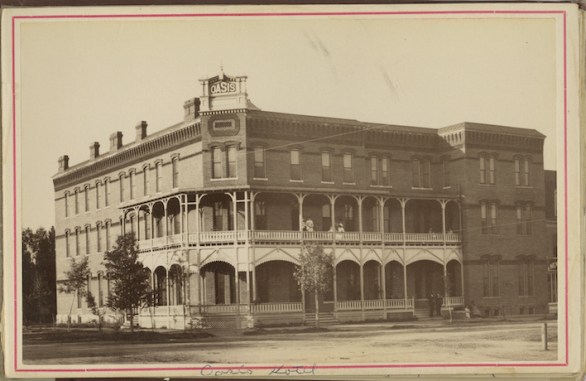This post identifies studio photographers active in Greeley between 1880 and 1887. See my earlier post for photographers working in the 1870s. This post shows how quickly some studios changed hands. Did I miss any photographers? Can you provide any additional biographical details?
1880
Orlando D. Shields (b. c. 1851-1935) was born in Mahoning County, Ohio. The 1880 census lists Shields as a photographer living in Greeley, Colorado, although no examples of his work have been found. For many years he operated a nursery business, selling fruit, shade and ornamental trees from his farm in Larimer County. Shields died on April 3, 1935, while visiting family in Long Beach, California.
George Wallace Wright (b. c. 1855-1931) was born in Maine. His older brother, Charles C. Wright, was also a photographer. Wright worked as a photographer in Chariton, Iowa, until June 1880, moving to Greeley, for his health. The town board permitted Wright to set up a temporary gallery in August. Later, he moved to Loveland, Colorado, and continued his trade. A tintype from this time notes that Wright ran a railroad picture car in Colorado and Wyoming.
For the next decade or so, Wright lived a peripatetic life, moving to Portland, Maine; Holyoke, Massachusetts; and Bath, New York. He settled in New London, Connecticut for several years before finishing his career in Laconia, New Hampshire. Wright died on December 9, 1931, in Tilton, New Hampshire.
1880, 1885-1886, 1891-1908 Clark M. Marsh (1833-1910) and his twin brother, Benjamin, were born on December 26, 1833, to Belorman Marsh and Mary Heller Marsh on a farm in Southport, New York.
Marsh, an early practitioner of photography, began making ambrotypes in Elmira, New York as early as 1856. On July 11, 1860 he married Charlotte E. Kellogg. By 1860 he moved his studio to Canandaigua, New York, offering photographs in lockets or pins for as little as 25 cents. He specialized in copying and enlarging daguerreotypes. In 1866 he updated his gallery with a new skylight. Marsh acquired the exclusive right to use Wing’s Patent Gem Camera, designed by Simon Wing. This camera used multiple lenses to produce tiny gem tintypes measuring approximately 1” by 1-1/4”.
In December 1866, Marsh took E. B. Lewis as a partner. Marsh & Lewis added a music store to the photo gallery. They sold organs, violins, pianos, sheet music and other musical merchandise. However, the partnership dissolved in May 1867. In January 1868, a fire damaged Marsh’s photography gallery. He quickly set up a new gallery on Canandaigua’s Main Street and became an agent for Grover & Baker Sewing Machines. But later that year, Marsh announced that he planned to move West and scheduled an auction to sell his household goods, including five mattresses, one marble-topped table, three good carpets, and three swarms of bees. He lived briefly in Painesville, Ohio, but returned to Canandaigua by the winter of 1869.
In March 1870 Marsh took J. C. Bushfield as a partner. They worked together for about five months. Shortly after that, Marsh relocated to Havana, New York, where his output included stereoviews of the local scenery, showing rocks, bridges, tunnels, cascades, and gorges.


1974.25.0022.
It was not until 1891 that Clark Marsh set up a permanent gallery in Greeley, purchasing goods for the studio in Denver. During the Christmas season, he took 65 baby pictures for free, which resulted in 400 portrait orders. In August 1895, Marsh offered free portraits to every potato farmer and planned to exhibit them on Greeley’s Potato Day. Two years later, he expanded his studio with a brick addition and added four new backdrops. By 1901, his son, Charles, “Chub” had joined the business. They offered Kodak cameras and supplies.
In October 1908, Marsh sold his photography business to E. Wallace. Shortly afterward, Marsh spent six months in San Diego, California visiting his daughter. Clark M. Marsh died on May 19, 1910, at the age of 76, due to heart failure while visiting family in Boise, Idaho. His body was returned to Greeley and he was buried at Linn Grove Cemetery. Clark M. Marsh was survived by four daughters and a son.

1882
Charles C. Wright (b. c. 1840-1887) Wright came to Colorado in 1882 from Indiana. His Greeley studio was located near the depot. In October 1882, he opened another studio in Denver over Reithmann’s Drug Store, at the corner of Fifteenth and Larimer streets. In early 1883, he turned over his Greeley studio to John R. King.
1882-1883
John R. King (b. c. 1853-1927) began his photographic career in Elmira, New York in the late 1870s. During the 1880s, he worked in photography studios throughout Colorado, including Denver, Central City, Boulder and Greeley, where he was often associated with C. C. Wright. In 1882, he managed Wright’s Greeley gallery, which specialized in photographing homes. King took possession of the gallery in January 1883, planning to only stay in Greeley for a couple of weeks, but demand for his services kept him in town until early February. Later that year he moved his photographic operations to Boulder. By 1891, King had returned to Elmira and worked various jobs, including bookkeeper and bartender.
1883-1885
E. W. Pierce (or Peirce) (b. c. 1836-1888) Born in Troy, New York, Pierce arrived in Greeley in September 1883, leasing Benjamin F. Marsh‘s studio. He published an accordion-style souvenir booklet of Greeley illustrated with nine photographs. In 1886, he relocated his gallery to Los Angeles, California.
1885-1886
Marsh Bros. Benjamin Franklin Marsh and his twin brother Clark M. Marsh worked together between the fall of 1885 and April 1886.
1885-1887

John Luther Koonz (1838-1890) was born in New York to Isaac Koonz and Roxana Jennings Koonz. J. L. Koonz married Catharine Mary “Kate” Dickerson on January 27, 1866, in Outagamie County, Wisconsin and they welcomed their first and only child, James, in July 1867.
By 1868, Koonz had opened a photography gallery in the rapidly growing town of Appleton, Wisconsin, on the Fox River. After 17 years in Appleton, the Koonz family moved to Greeley, Colorado In 1885. Initially, John operated the studio independently, but a year later, his son James A. Koonz (1867-1917) joined him.
In the late 1880s, the family moved to Herkimer, New York. Unfortunately, John L. Koonz died of cancer on July 19, 1890. His remains rest at Prospect Hill Cemetery in Gloversville, New York.
Thank you to Miranda Todd, Archives Assistant, Greeley Museum, for research assistance and providing scans and to Beverly W. Brannan for proofreading this post.




